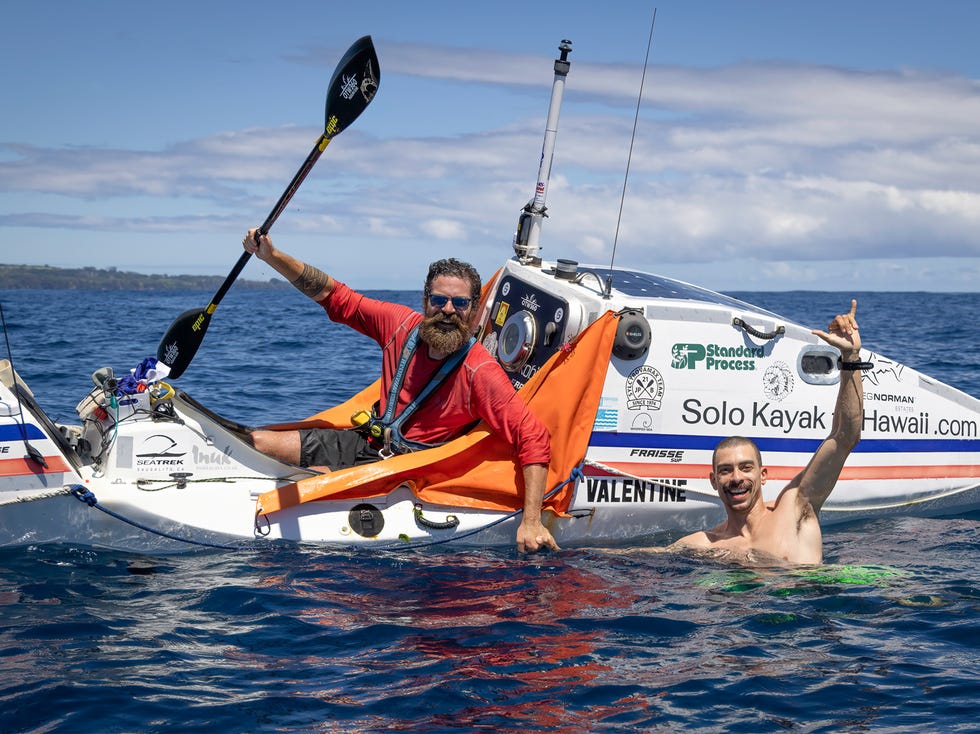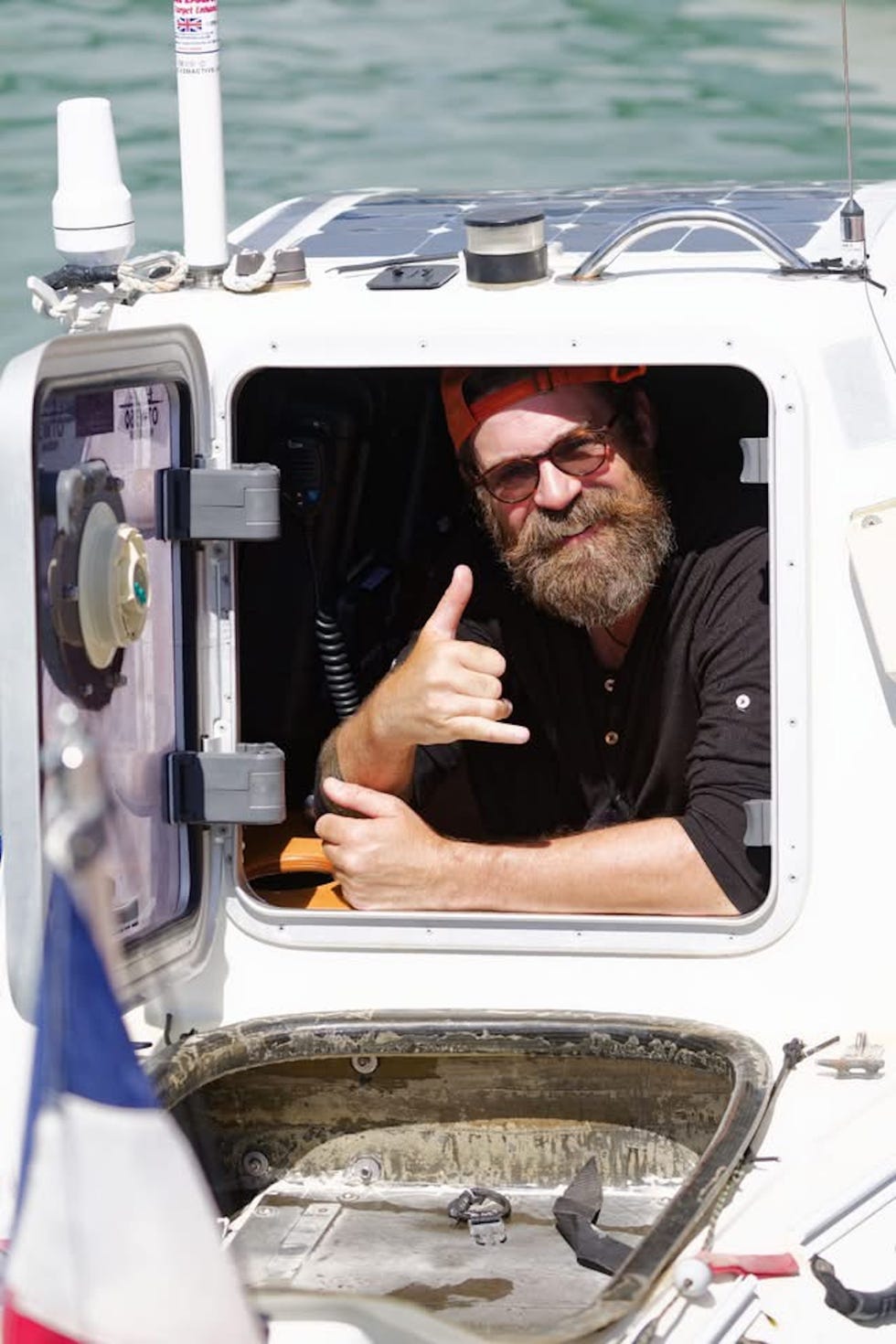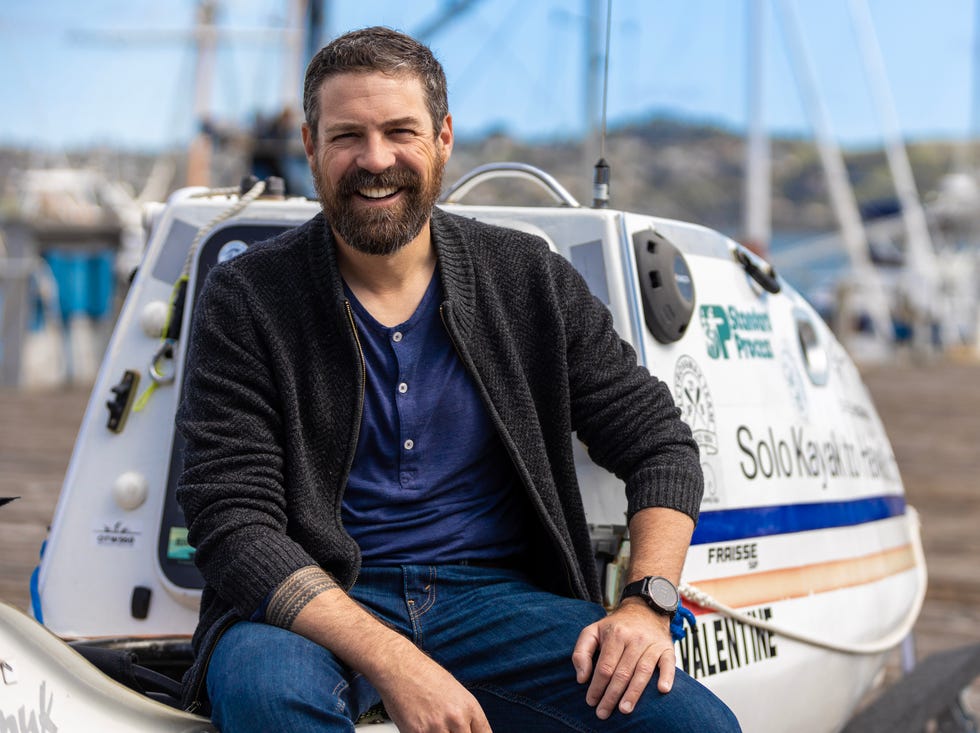I Kayaked Across the Ocean Solo in My 40s. Here Are the Messy Details.

Cyril Derreumeaux, 48, Sausalito, California
I awaken in my kayak, about a half hour before sunrise. I’m so low to the water that any wave could swamp my cockpit. After I prepare my food for the day—freeze-dried meals that total 4,000 calories—I check messages on my Garmin InReach about the weather, the force of the winds. Based on that, I decide on what clothes to wear: Do I get the complete foul-weather outfit or shorts and a windbreaker? As soon as the sun rises, I dip my double-blade in the water and start to paddle.
I keep watch for obstacles. Whales can push my boat around. I could hit a floating container or the ship it fell from at any time. It requires discipline to do this all day, while also thinking about my health. What if I cut myself? Hurt my eyes? Or have GI issues?

Derreumeaux is the first person to solo kayak across two different oceans.
At noon, I take an hour break. I retreat inside my cabin. It’s the tiniest one man tent—almost like a coffin. If I sit down crisscross, my head tilts forward. I run a desalination device that makes sea water drinkable, which produces the one gallon I need for daily hydration. Once I’m done, I get out and paddle another five hours. If the weather is favorable, and I’m making good mileage, I might do another an hour or two. Then I have time to wind down. I go back in the cabin and clean the salt off my body.
After the sun goes down, I wake up every hour to check my plotter. I’ve got a piece of equipment called the Automatic Identification System, or AIS, that broadcasts my position to other boats. But I still have to be aware, so I look to make sure there are no ships coming my way. When I reach the middle of the night, I wake up to hydrate and eat before going back to sleep.
I’m wet all the time—even my sleeping bag is wet. There’s no comfort. But I push my boundaries over and over again, every day for months, for as long as it takes to get all the way across the ocean.
There have only been five ocean crossings in a solo kayak. I was number five, and I’m the first to have done two different oceans: the Atlantic and Pacific.
My first journey was from California to Hawaii in 2022. I had to make two attempts. On my first attempt, a storm was so bad that I was stuck in my kayak. I was attached to the boat by a belt on my chest and my hips. For three days and three nights, I couldn’t move. I was inside, just waiting it out. I put out the sea anchor, which is an underwater parachute that turns me perpendicular to the waves, but it became entangled with the rudder. I called the Coast Guard after just a week.
I didn’t just wake up and say, “I’m going to cross an ocean.” It took years for my body to accustom to those kinds of distances, and, because I was alone, I had to be physically, mentally, and emotionally prepared at all times.

Derreumeaux’s route across the Atlantic Ocean.
I trained my body to be able to paddle from sunrise to sundown. It’s not a sprint—I would go easy—but it was still hard on my joints and tendons, and I could’ve gotten an overuse injury. To prevent that, I trained the muscles I use to paddle: My lower back, core, tendons, and joints.
I worked with a company that tests VO2 max, a metric that measures cardiovascular fitness. They came up with a regiment for how many hours and feet-per-minute of paddling I needed to work up to. The training wasn’t just kayaking, though. I also cycled, swam, ran, and did yoga.
I assembled a support crew. My land support, Dave, lives in Santa Cruz. He’s adventured with me before, so he knows my personality. He’s fact-based and gives advice without emotion. He’d call off the whole thing if he felt like I was in danger. My professional weather router, Michel, lives in France. He gave me waypoints for where I need to go—a GPS location—every day. He also provided a three-day weather pattern. If a storm was coming up, he’d tell me to be patient.
I had a satellite phone in case I needed to contact the Coast Guard or call for extra help. For example, what if there was an equipment issue? What if water came into my compartment, and I needed to do some carbon fiber or fiberglass epoxy work? In those situations, I needed advice before I try to fix anything.
After a month on the water, my mind went into a different mode. I didn’t talk to myself; I was always aware of what I was doing. But something changed in me. Anything that brought me optimism, I took in.

Derreumeaux inside the cabin of his ocean kayak.
I missed my loved ones—parents, kids, and friends—on land. So, I humanized objects and animals. Let’s say it was wet and “Frenchie,” my flag, moved in a weird way. “Oh, you’re not happy because you’re wet,” I’d say. Maybe I’d see a fish and talk to it: “Fishy, you want to follow me? Come on, just be my friend.” And then the fish might follow me for two or three days.
A bird came to see me every day for a couple months. “Oh, you’re coming to check on me?” I’d ask. “That’s so nice of you. We’re in this together.”
Once, I saw a swordfish as big as my boat—about twenty-three feet long. I’m way more afraid of swordfish than sharks. Sharks looked at me like, “Okay, you’re not food,” then went away. But I was powerless against swordfish, which can put a big hole in rowing boats. I was like, “Oh my God, just go away, please.” Finally, after fifteen minutes, it did.
After three months, I felt something I call the Oneness. I felt so connected to the ocean, so connected to everything, that I embraced my vulnerability, my death. Life became all about being in the moment. It’s everything that’s in Buddhism and meditation—but I lived it.

Derreumeaux poses with his ocean kayak, named Valentine.
Those three months seemed like forever, but on the scale of my life, it was nothing. And yet it changed the way I see the world. Just watching birds, being a dad, taking a shower, drinking a cold beer—everything is enhanced.
I can’t do small talk anymore. I need conversations to be meaningful—about love, friendship, and purpose—all because of what I’ve experienced. It’s hard for people to understand. When I try to tell them what I felt, there’s a discrepancy between my message and what they hear. A project like this is all about having a vision—even when nobody else does. So, when I finally saw land after three months, it felt so rewarding.
I sought a life experience I didn’t know about. To learn something new by escaping my comfort zone. Anyone who has crossed oceans, mountains, or deserts experiences the Oneness. And I hope that more people seek it. So many will go through life without even knowing that it exists.
After completing my Atlantic crossing earlier this year, I think I need at least two years to settle down and grow roots again. There’s going to be a call for freedom, for the feeling of adventure. I don’t know what form it will take. Maybe another ocean expedition. But it could also be something else. I’ve lived without people for three months. What about an expedition where I do the opposite, where I connect with as many people I can?
I keep my mind open. But I know that there’s going to be something. At 48 years old, I still have 30 years of adventure ahead.
esquire




